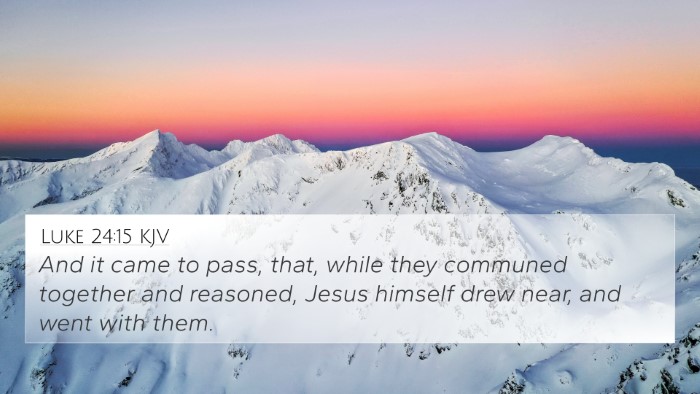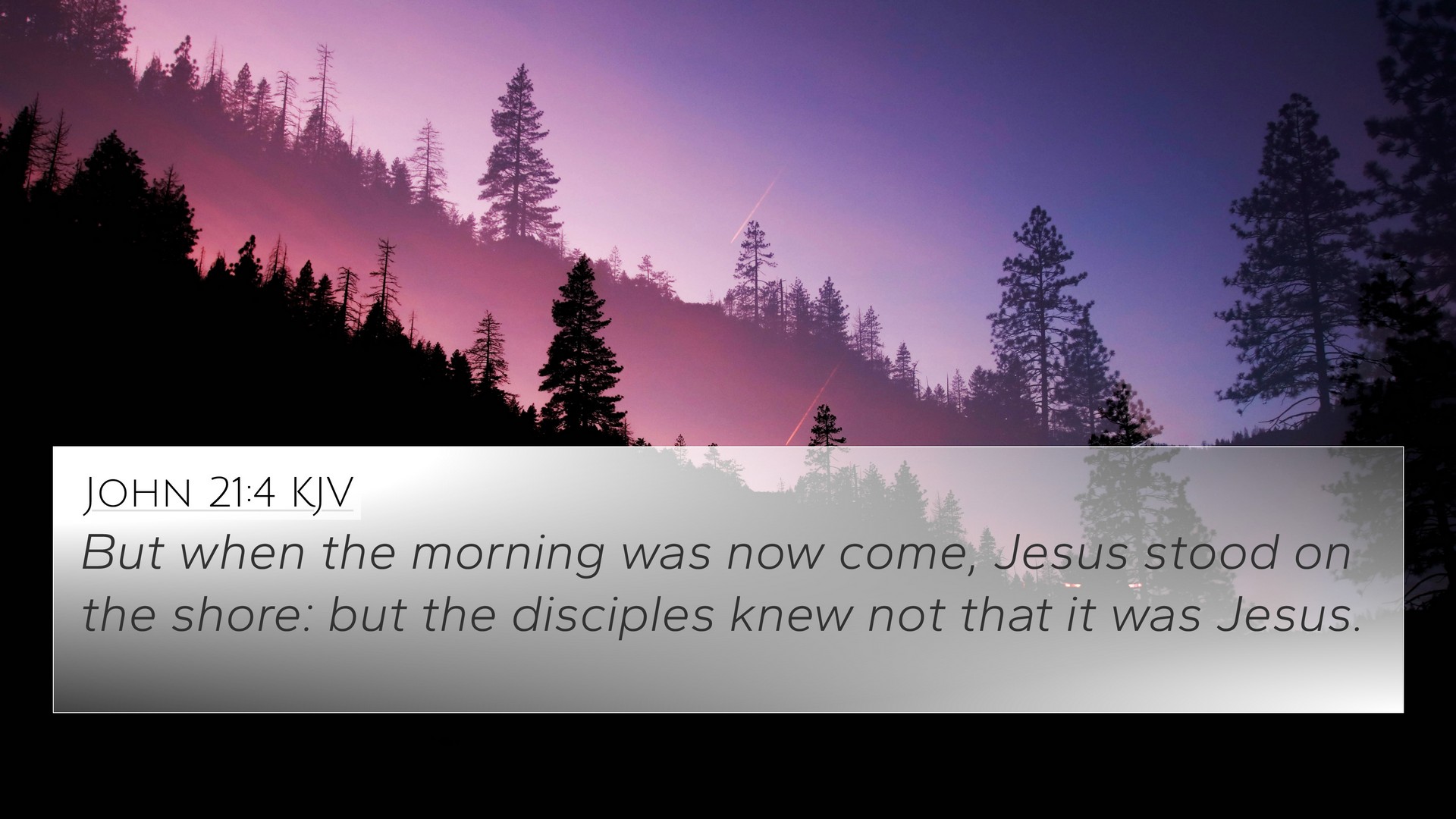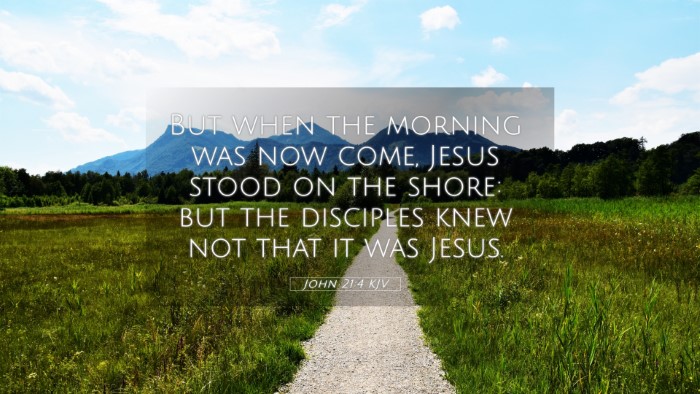Old Testament
Genesis Exodus Leviticus Numbers Deuteronomy Joshua Judges Ruth 1 Samuel 2 Samuel 1 Kings 2 Kings 1 Chronicles 2 Chronicles Ezra Nehemiah Esther Job Psalms Proverbs Ecclesiastes Song of Solomon Isaiah Jeremiah Lamentations Ezekiel Daniel Hosea Joel Amos Obadiah Jonah Micah Nahum Habakkuk Zephaniah Haggai Zechariah MalachiJohn 21:4 Similar Verses
John 21:4 Cross References
But when the morning was now come, Jesus stood on the shore: but the disciples knew not that it was Jesus.
Uncover the Rich Themes and Topics of This Bible Verse
Listed below are the Bible themes associated with John 21:4. We invite you to explore each theme to gain deeper insights into the Scriptures.
John 21:4 Cross Reference Verses
This section features a detailed cross-reference designed to enrich your understanding of the Scriptures. Below, you will find carefully selected verses that echo the themes and teachings related to John 21:4 KJV. Click on any image to explore detailed analyses of related Bible verses and uncover deeper theological insights.

John 20:14 (KJV) »
And when she had thus said, she turned herself back, and saw Jesus standing, and knew not that it was Jesus.

Luke 24:15 (KJV) »
And it came to pass, that, while they communed together and reasoned, Jesus himself drew near, and went with them.

Mark 16:12 (KJV) »
After that he appeared in another form unto two of them, as they walked, and went into the country.

Luke 24:31 (KJV) »
And their eyes were opened, and they knew him; and he vanished out of their sight.
John 21:4 Verse Analysis and Similar Verses
Understanding John 21:4
John 21:4 states: "But when the morning was now come, Jesus stood on the shore: but the disciples knew not that it was Jesus." This passage is rich in meaning and carries significant theological implications, particularly in the context of Jesus’ post-resurrection appearances. Drawing insights from several public domain commentaries, we can explore its meaning through various lenses.
Contextual Background
The setting of John 21 occurs after the resurrection of Jesus, where He reveals Himself to His disciples. This chapter illustrates critical themes of recognition, mission, and the continuation of Jesus' ministry through His disciples.
Interpretation from Matthew Henry
According to Matthew Henry, the verse highlights the disciples' initial inability to recognize Jesus. He notes that this lack of recognition points to the transformative nature of resurrection; Jesus' divine nature is now more pronounced, and His form may have changed to some extent, which contributes to their failure to identify Him. Furthermore, Henry emphasizes the importance of the presence of Jesus in the believer's life, suggesting that even when He seems distant ("stood on the shore"), His involvement in their lives is constant.
Insights from Albert Barnes
Albert Barnes provides a detailed analysis of the disciples' state of mind. He explains that they were in a state of uncertainty and despair after Jesus’ crucifixion. The appearance of Christ, even unrecognized, serves as a reassurance to the disciples that their purpose was not abandoned. Barnes connects this to the broader narrative of Jesus' ongoing guidance and provision for His followers, symbolizing hope and restoration.
Analysis by Adam Clarke
Adam Clarke interprets the verse in the context of Jesus directing His followers in their mission. He argues that the physical distance between Jesus and the disciples reflects the spiritual distance often felt by believers when they are not attuned to the presence of Christ. Clarke posits that knowing Christ intimately allows believers to recognize Him in their lives, emphasizing the need for spiritual awareness and engagement with faith practices.
Thematic Connections
John 21:4 invites readers to explore various themes prevalent in scripture. Here are vital Bible verse cross-references that illustrate connections in the narrative:
- Luke 24:15-16 - The road to Emmaus, where disciples also fail to recognize Jesus.
- Matthew 28:7-10 - The angel’s announcement of Jesus' resurrection to the women, marking the beginning of recognition.
- John 20:14-16 - Mary Magdalene's encounter with Jesus, emphasizing personal recognition.
- Acts 1:9-11 - Jesus' ascension and the recognition of His authority.
- Revelation 1:17-18 - John's vision of the glorified Christ sheds light on His divine identity.
- Matthew 14:26-27 - The disciples' fear when encountering Jesus on the water, again highlighting initial ignorance of His presence.
- 1 Corinthians 15:5 - Paul mentions Jesus' appearances to the disciples and the importance of recognizing His resurrected glory.
Comparative Bible Verse Analysis
In contemplating this scripture, it’s vital to apply a broader comparative analysis approach. The connections between Bible verses allow a deeper understanding of the role of Jesus and the disciples' journey from doubt to recognition. For instance, aligning this verse with the aforementioned cross-references shows how Jesus continually pushes for recognition and faith among His disciples.
Tools for Bible Cross-Referencing
Utilizing tools such as a Bible concordance and a cross-reference Bible study guide can enhance one's understanding of interconnected scriptures. These tools are invaluable for individuals seeking to explore connections between Bible verses and deepen their spiritual knowledge.
Applying Cross-Referencing in Study
When studying the Bible, employing the Bible cross-reference system can illuminate how various texts speak to similar themes or events. For instance, reflecting on the theme of recognition seen in John 21:4 alongside Luke 24:15-16 creates a richer narrative of understanding Jesus' presence and mission.
Conclusion
In summary, John 21:4 serves as a profound reminder of the disciples’ initial blindness to Jesus’ presence post-resurrection. This reflection resonates with believers today, inviting them to be aware of Jesus’ continual work in their lives. By using cross-referencing Biblical texts, readers can unify various scriptures, illustrating the cohesive narrative of hope, recognition, and divine purpose throughout the Bible.


